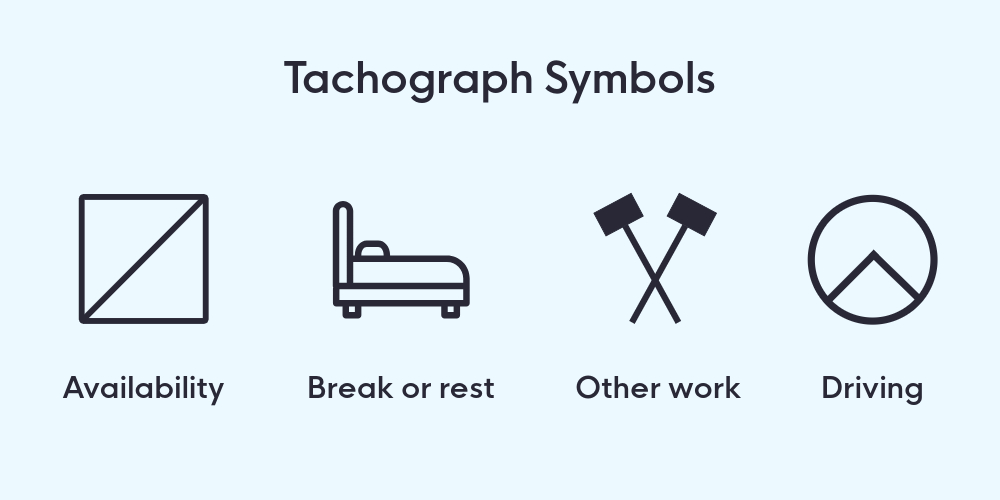If you’re working in road transport, you’ve probably heard the term POA thrown around, but what are periods of availability, really?
In short, it’s a block of time where a driver isn’t doing any work or driving but must still remain available to get going when required.
In this guide, we’ll explain how periods of availability (POA) works, how it differs from breaks and rest, and how to record it correctly using a tachograph.
What we’ll cover
What is a period of availability (POA)
A period of availability is defined as the time when a driver is not working but must still be ready to start work again at short notice. It’s not counted as a break or rest period, but it’s also not classed as active work. To qualify as a POA, the driver must know how long the period will last before it begins.
POA exists to give flexibility to both employers and drivers. It typically applies to scenarios like waiting at borders, depots, or ferry terminals. The important bit is that the duration is predictable and the driver isn’t doing other tasks like loading or paperwork.
If you’re trying to get your head around period of availability and what HGV drivers need to log, think of it as “standby” mode (present but not active). POAs are only one part of the puzzle when managing HGV drivers’ hours. But used properly, they help drivers stay compliant and reduce burnout.
Key characteristics of POA
- Defined in advance: POA must be clearly outlined before it begins. It’s not just free time during the day, it has to be a known, expected pause between tasks. Drivers should never be left guessing how long they’ll be waiting.
- No additional duties: During a period of availability, drivers must not be expected to do anything else. That includes admin work, vehicle checks, loading, or unloading. If you’re doing tasks, it no longer qualifies as POA.
- On standby: The driver has to be available to start working again immediately if needed. That means being present and alert, even if you’re not actively working. It’s a passive period, but not time off.
- Useful for operators: For anyone running a small haulage business, POA offers a bit of breathing room without affecting compliance. It can help balance workloads across multiple drivers. That’s why it’s important to log it correctly and consistently.
Examples of POA scenarios
Let’s say you arrive early at a depot and are told your loading slot is in 45 minutes. That waiting time, if known in advance, is a perfect example of a POA. The key point is that you’re not expected to do anything during the wait.
Another example could be a ferry crossing that takes 90 minutes and where you’re required to stay with the vehicle. You’re not resting, but you’re not working either, and you knew the timing in advance. That’s another tick for a period of availability HGV rules.
Time spent as a passenger in a second vehicle, while being transported to a job site or returning from one, may also count. But again, only if you know how long the ride will take and aren’t expected to perform other duties during it.
These examples are common across the transport sector and important to get right.
Differentiating POA from breaks and rest periods
Understanding the difference between POA, breaks, and rest periods is really important. These are separate time categories with different rules under the working time directive. Getting them confused can lead to incorrect tachograph records and potential fines.
Breaks versus POA
Breaks are legally mandated pauses from work, usually 45 minutes after 4.5 hours of driving. During a break, a driver must not be available for work at all. POAs, on the other hand, require you to remain ready for work even if you’re not actively doing anything.
If you’re on a break, you can’t be interrupted. But on a POA, you can be called back to action. That’s why these two things are never interchangeable, even if they might seem similar on the surface.
Rest periods versus POA
Rest periods are longer, off-duty times where a driver must be free from all work responsibilities. Think daily or weekly rest: at least 11 hours daily or 45 hours weekly. This time is yours, and you’re not expected to work or be on call.
POA is more like being “on hold” at work and it doesn’t replace your rest. Misclassifying POA as rest can lead to non-compliance with drivers’ hours rules.
If you’re starting a haulage company, understanding this distinction is important from day one.

Common situations where POA applies
POA isn’t just a technical rule; it comes up in plenty of real-world driving situations. From scheduled delays to long-distance trips, knowing when to use POA correctly can make all the difference.
Let’s look at a few everyday examples where it applies.
Waiting times with known durations
The classic case is waiting at a loading bay or freight terminal, where you’re told it’ll be a 30–60 minute wait.
If this is confirmed in advance, and you’re not asked to help during that time, it’s a POA. It keeps your working time calculations accurate without cutting into your legal breaks or driving time.
This kind of wait is common in busy depots, especially for just-in-time deliveries. Whether you’re an employee or an owner-operator, logging it as POA is the compliant approach. And if you’re aiming to become an HGV driver, you’ll need to learn this early on.
Travelling as a passenger during work hours
Sometimes drivers are transported between sites or jobs.
If you’re riding in the cab but not working or driving, this may count as POA. Again, the golden rule is: you must know the duration in advance.
If the ride is unscheduled or you’re doing tasks during the journey, it’s not POA. But a known 2-hour transfer with no work expectations? That qualifies. This comes up more often than you’d think in multi-driver or relay jobs.
Recording POA using a tachograph
Periods of availability must be logged using the correct mode on your tachograph. It’s usually marked by a square symbol with a diagonal line through the middle. Switching to this mode helps separate it from driving, working, or rest periods.

Accurate tachograph use is required for compliance with tachograph laws. If you get audited or checked during a DVSA roadside inspection, clear records will be your best friend. Plus, it makes life easier when reviewing shifts, pay, or hours limits.
For transport managers, reviewing POA entries can reveal patterns and delays. If you see repeated long POAs at one location, it may be time to change routes or carriers.
These insights help keep operations smooth and costs under control.
Importance of POA in managing working hours
Correctly using periods of availability means you can maximise time on the road without breaking legal limits. It also protects drivers from fatigue and ensures they’re not working too many hours unrecorded.
Especially for new operators or small teams, understanding periods of availability helps keep everything above board when undertaking haulage contracts.
Drivers also benefit. Logging time properly avoids being penalised or overworked. When everyone knows the rules, the whole operation runs more efficiently.
From planning shifts to avoiding burnout, POAs are part of a smart, safe working strategy. They’re not just about ticking boxes, they’re about protecting your people and your business. When used right, they support long-term growth and compliance.
Conditions for a valid POA
- Advance knowledge: The driver must know the expected length of the period before it starts. This can’t be vague or left open-ended, it needs to be clearly communicated in advance.
- No work performed: The driver cannot be asked to complete any job-related tasks during this time. That includes paperwork, vehicle checks, or assisting with loading.
- Availability to resume work: The driver must remain ready to start working again as soon as required. This means they can’t use the time as a break or rest period.
Whether you’re managing a team or running solo, these rules matter. Keeping them in mind helps you avoid penalties and build trust with clients and regulators. They also form part of getting your operator licence and staying compliant.
Frequently Asked Questions
What is a period of availability for HGVs?
A period of availability in HGV refers to a known window of time during which a driver is not working or driving but must remain available to start work again if needed. It typically applies to situations like waiting for a set delivery slot or travelling as a passenger when not working. These periods must be recorded properly using a tachograph.
Is period of availability paid?
Whether POA is paid depends on your employment contract or company policy. Some employers treat it as paid standby time, while others do not include it in hourly pay. It’s important to clarify this with your employer or include it in your contract.
Is POA classed as a break?
No, POA is not a break, it’s a separate category of time altogether. During a break, you must be completely free of work duties and not available for any tasks. POA, on the other hand, means you’re not working but still on standby.
Do van drivers need to monitor POA?
No, POA only applies to HGV drivers. If you have a mixed fleet of HGVs and courier vehicles, you only need to account for this with your haulage vehicles.




